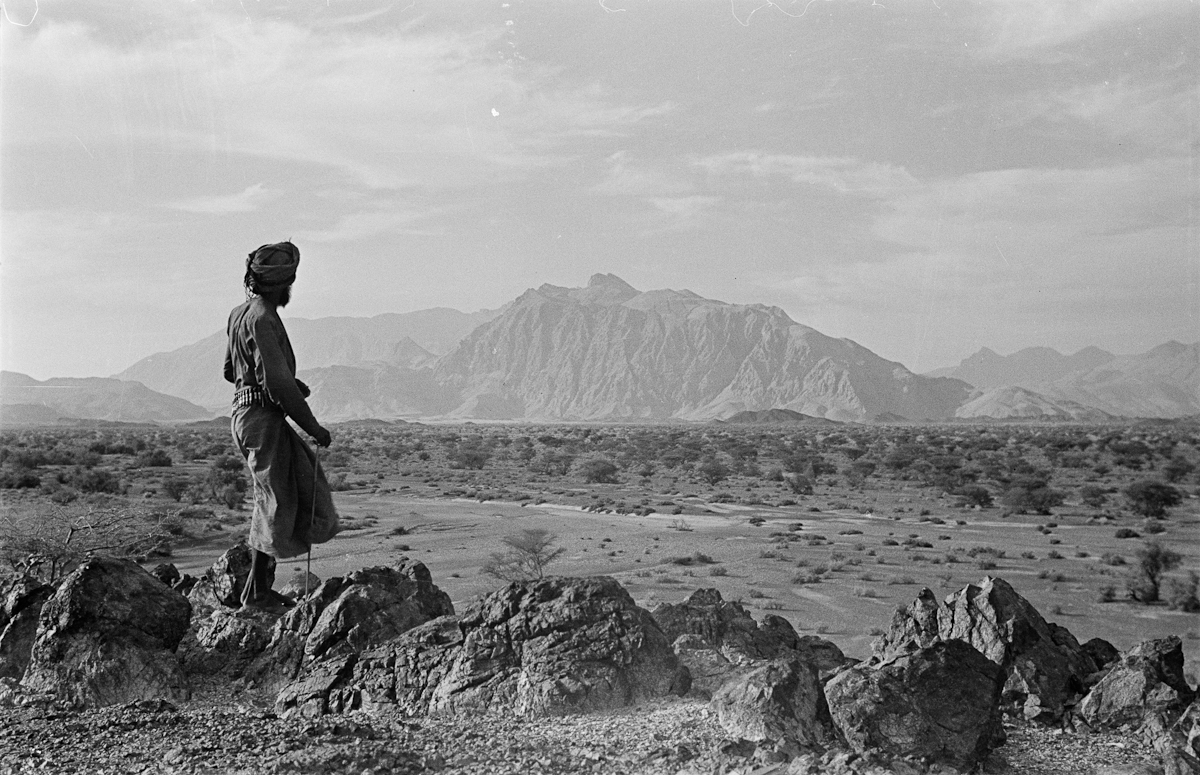Thesiger's Journeys in Arabia - United Arab Emirates and Oman Spring 1949
 2004_130_22682_1-OJourney dates: January 28, 1949 – April 24, 1949
2004_130_22682_1-OJourney dates: January 28, 1949 – April 24, 1949
When Wilfred Thesiger returned to Al Ain at the end of January 1949, he found preparations for his journey through Oman already well under way. Two of his Rashid Bedouin companions, Musallim bin Al Kamam and Sahail bin Tahi, had arrived at Al Muwaiji Fort, and Sheikh Zayed bin Sultan Al Nahyan, then the Ruler's Representative in Al Ain, had arranged two trusted Awamir Bedouin guides for the journey: Mahalhal bin 'Ati and Muhammad bin Al Jabari.
Although Thesiger had intended to travel secretly into Oman, suspicion about his plans was already widespread in the region. When Thesiger departed Al Ain on January 28, the party tried to allay suspicion by heading due west into the Al Khatam and Al Humrah sands, intimating that the party was travelling into the Empty Quarter. After two days the party turned south, stopping at Qusaywirah well to pick up two more guides, Hamad al Mahri, a Mahra Bedouin retainer to Sheikh Zayed, and Salim bin Habarut, a shiekh of the Junuba Bedouin.
As the party crossed into Oman's Wadi al 'Ayn, the weather turned cold. Soon after the party stopped at Al Kiran, they met with a hostile force of Duru Bedouin intent on keeping Thesiger out of their territory. After many hours of tense negotiations, Thesiger and his party were allowed to continue onwards providing they skirted Duru Territory by travelling through the Ramlat Umm as Samim and the Ramlat al Ghirbaniyat along on the eastern edge of the Empty Quarter. Reaching Raqa well on February 16, Thesiger's party continued south to Jiddat az Zawilyah, and then headed east to Sharqiyah Sands, Furai well and the Shib al Raqq. At Nafi well, Thesiger, Salim bin Kabina, Hamad al Mahri and Sultan, a Wahiba Bedouin guide, broke from the main party on March 11 to loop through the Sharqiyah Sands to Batha' Badiyah, later rejoining the party in the Wadi Halfayn on March 21.
As the party headed north, news of their whereabouts spread throughout the region, and a party of armed guards was sent by the Imam of Oman to arrest Thesiger. The party was forced to halt near Jabal al Akhdhar, also known as Green Mountain, but eventually, with the help of Yasir bin Hamud, a Junuba Bedouin shiekh, Thesiger was granted a pardon. Proceeding north along the foothills to Ibri, Thesiger's party arrived back at Al Muwaiji Fort in Al Ain on April 6, 1949.
Locations: Al Khatam, Al Humrah, Umm az Zamul, Wadi al 'Ayn, Ramlat al Ghirbaniyat, Sharqiyah Sands, Furai, Shib al Raqq, Haij, Tawi Harian, Batha' Badiyah, Wadi al Batha', Qabil al Bu Said, Wadi 'Andam, Wadi Halfayn, Buraymah, Wadi Sayfam, Jebel Kawr, Jabal Buwaydah, Al Qabil, Jabal Hafit [Jebel Hafeet], Al Ain City, Al Muwaiji.
Named People: Alaiwa bin Lutaiya, Ali bin Said bin Rashid, Hamad [Hamad al Mahri], Huaishil, Mahalhal bin 'Ati, Muhammad bin Al Jabari, Musallim bin Al Kamam, Sahail bin Tahi, Salim bin Habarut, Salim bin Ham, Salim bin Kabina, Sheikh Khalifa bin Zayed Al Nahyan, Sheikh Zayed bin Sultan Al Nahyan, Wilfred Patrick Thesiger, Yasir bin Hamud
Represented Cultural Groups: Rashid Bedouin, 'Ifaar Bedouin, Awamir Bedouin, Duru Bedouin, Junuba Bedouin, Mahra Bedouin, Manasir Bedouin, Wahiba Bedouin, Iranian, Baluch
References:
Wilfred Thesiger, 1950. 'Desert Borderlands of Oman', The Geographical Journal, Vol. 116, No. 4/6.
Wilfred Thesiger, 1960. Arabian Sands, Longmans, Green and Co Ltd: London.
Images:

































































































































































































































































































































































































































































































































































































































